
International Embryo Technology School Bovine Reproduction Articles
Ensuring a Rewarding Return on Your Embryo Investment
Post Date: November 14, 2023
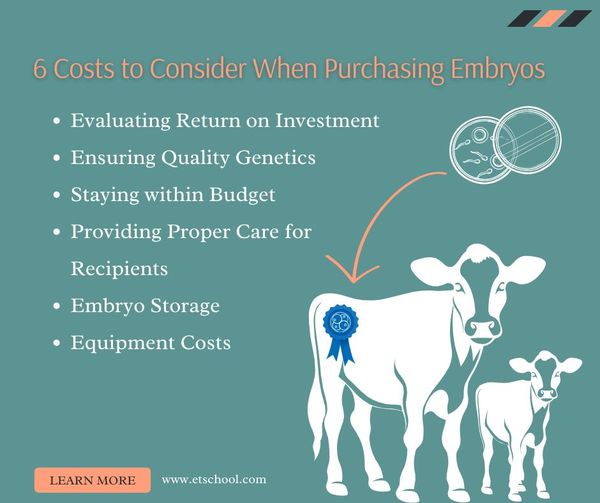
Advice to Ensure a Rewarding Return on Your Embryo Investment:
Quality should take precedence over quantity when managing embryo costs. While average bovine embryos might cost around $500, those from champion bloodlines can reach a hefty $2500. For new producers entering the world of embryo transfer, this financial investment can be substantial. For this post we are giving some insider advice to ensure a rewarding return on your embryo investment.

How To Mitigate Cattle Costs in Embryo Transfer
Post Date: October 31, 2023
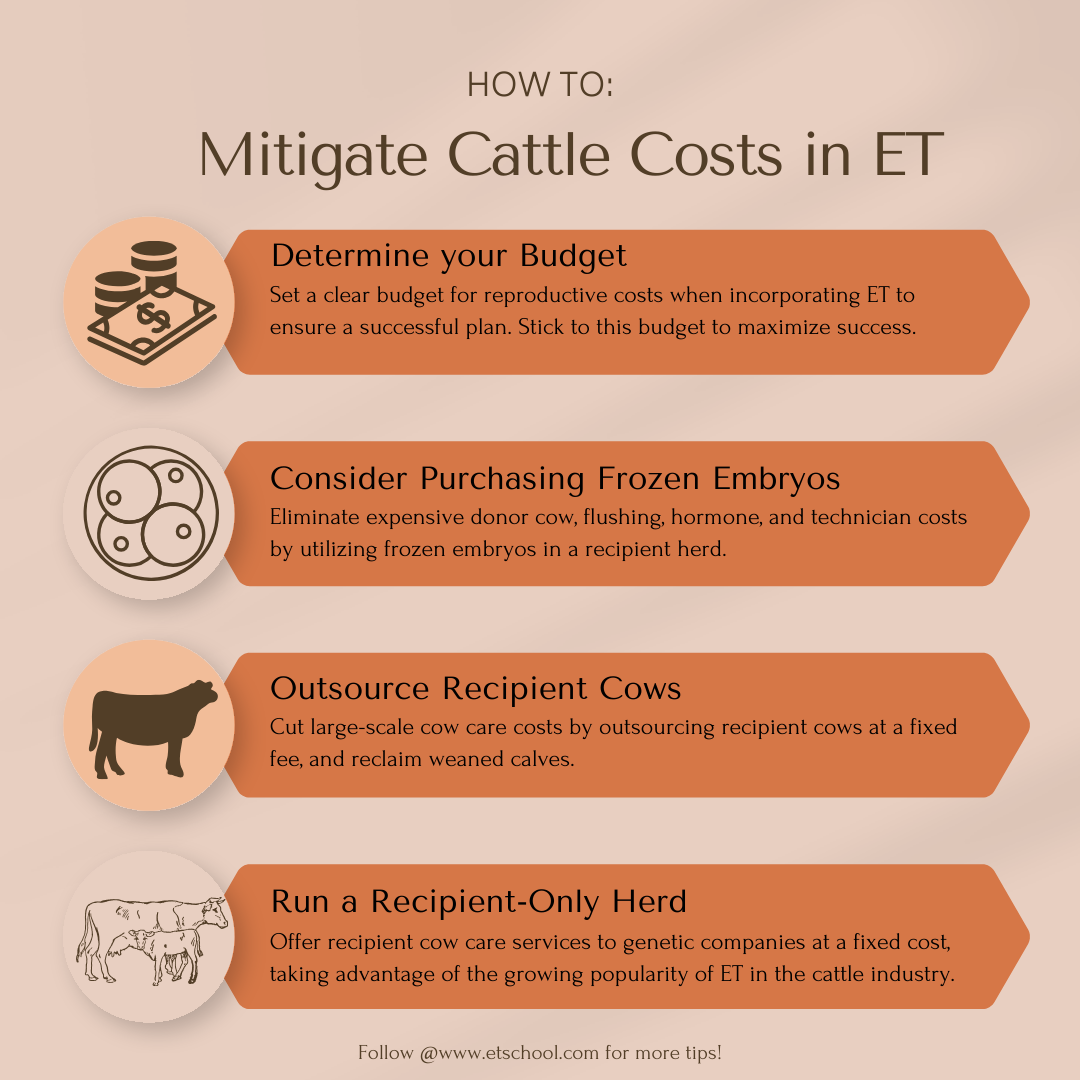
Are you interested in implementing ET, but worried about the start-up cattle costs?
Let's dive into a conversation about the expenses associated with donor and recipient cows in embryo transfer, and how you can take steps to mitigate these costs while ensuring the health and productivity of your herd.
Embryo transfer is an invaluable technique for genetic improvement in cattle, but it can be quite an investment. Donor cows, recipient cows, labor, and the whole process can quickly add up. Here are a few strategies that might help you manage those costs effectively:

Enhance Your Operations Reproductive Efficiency
Post Date: October 17, 2023
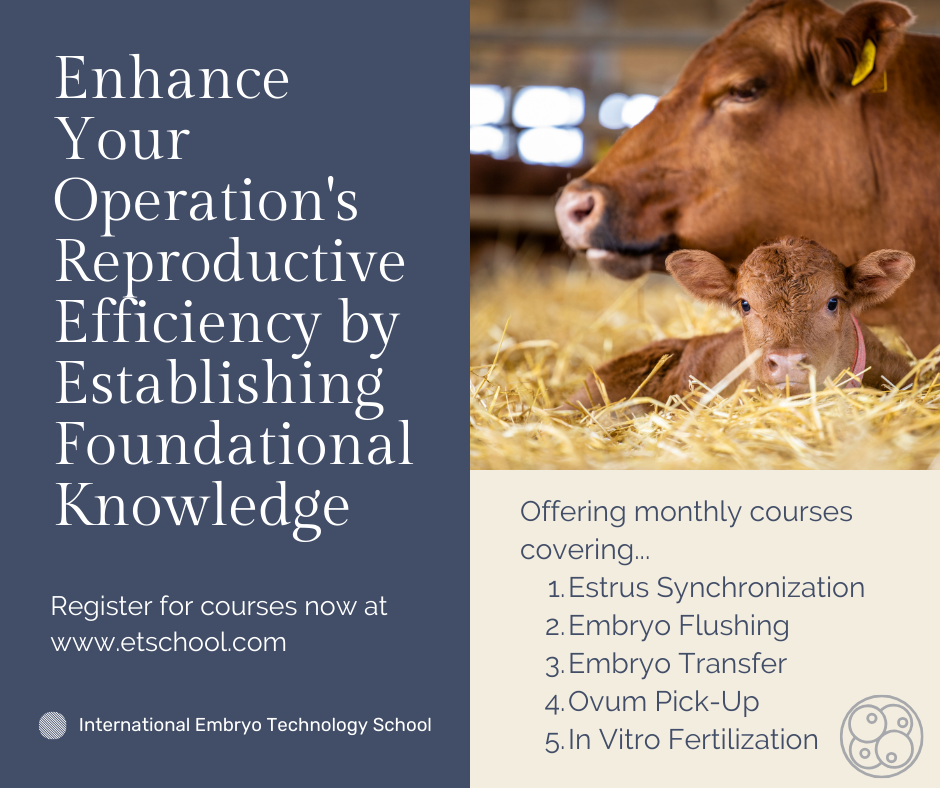
Let's tackle a fundamental question for producers considering adding embryo transfer to their breeding program: "What is it going to cost?"
Understanding the costs associated with embryo transfer can be complex and multifactorial, with one of the most significant expenses being outside labor. However, there's a solution – attending classes at the International Embryo Technology School can help you offset these costs significantly.

Managing a Thriving Cow-Calf Operation Without a Herd Bull
Post Date: October 3, 2023

In the dynamic world of cattle ranching, the integration of cutting-edge techniques like Artificial Insemination (AI) and Embryo Transfer (ET) has ushered in a new era of managing a prosperous cow-calf operation. I this post, we're shedding light on how this approach can not only work but thrive within your operation:

The Synergy of Embryo Transfer and Herd Bulls in Cattle Breeding
Post Date: September 26, 2023
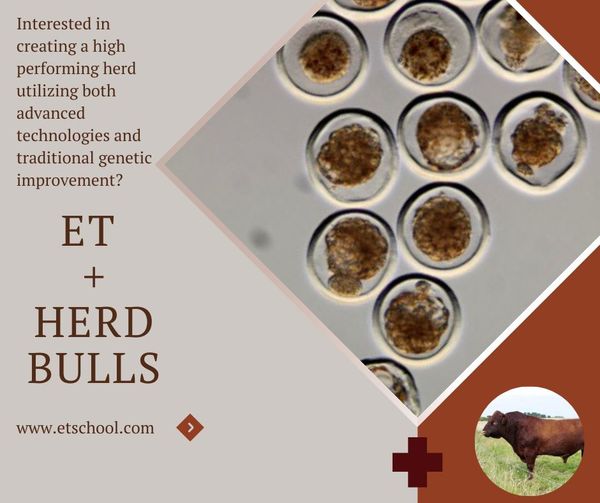
Introducing embryo transfer (ET) into your cattle operation is a path that holds great promise for profitability. The International Embryo Technology School, designed to assist producers and veterinarians in seamlessly incorporating this technology into their current practices. This post let's explore how, when combined with a herd bull, ET can yield valuable embryo calves while ensuring maximum pregnancy rates within your herd.

Using Artificial Insemination and Herd Bulls
Post Date: September 19, 2023
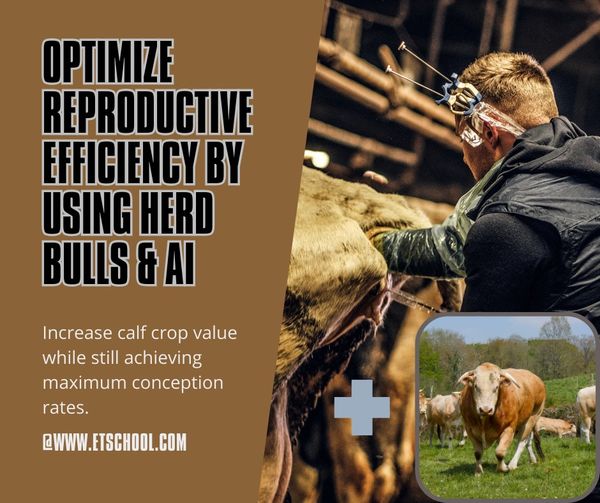
Harnessing the Best of Both Worlds: AI and Herd Bulls in Our Cattle Herd
At the International Embryo Technology School, we believe in combining the power of modern technology with the reliability of tradition. In this post we will demonstrate how you can embrace both Artificial Insemination (AI) and herd bulls within your cattle breeding program. Here's how we make these two approaches work seamlessly together:

The Power of the Herd Bull
Post Date: September 12, 2023

The Power of the Herd Bull: Simplicity in Cattle Breeding
In a world abuzz with cutting-edge technologies, there's something beautifully uncomplicated about the role of a herd bull at your operation. This post we will discuss the advantages of solely using herd bulls and how to maximize their efficiency.

Navigating the Bull Dilemma
Post Date: September 5, 2023
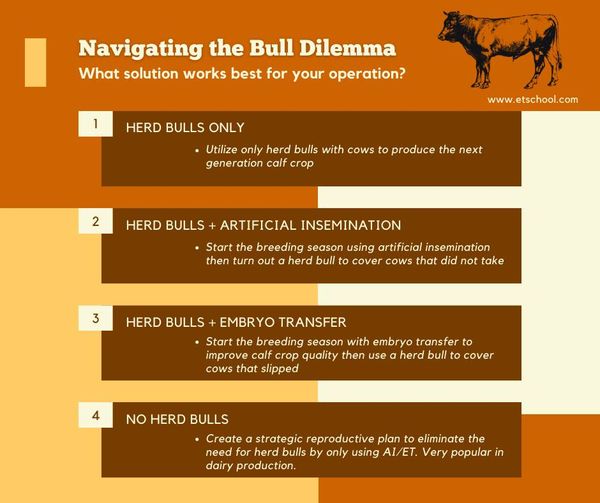
In today's ever-evolving world of cattle ranching, the role of the bull in your operation is a hot topic. Especially in dairy farming, bulls can be a handful - they're strong, sometimes aggressive, and costly to house. But when it comes to managing a cow-calf operation, sometimes they're your best (or only) option.

Steps of Bovine In-Vitro Fertilization IVF
Post Date: August 29, 2023
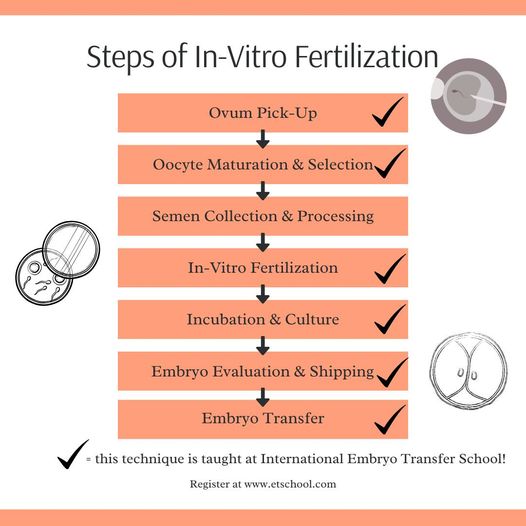
Ever wondered about the technique of in-vitro fertilization (IVF)? Wondered how it can be incorporated into your cattle operation? If you currently use frozen embryo transfer, you may already be using an IVF embryo. For this post, we are going to break down the IVF process in beef cattle reproduction, specifically for embryo transfer.

Incorporating Sexed Semen Into Your Breeding Program
Post Date: August 22, 2023
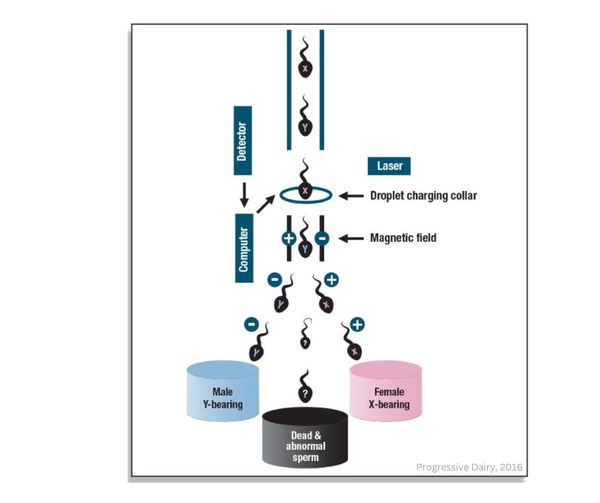
Have you ever thought about incorporating sexed semen into your breeding program? If so, this post is for you! If not, keep reading and depending on your operation goals may decide this technology could work for you.
Sexed semen refers to a specialized type of semen used in animal reproduction, where the sperm cells have been separated or sorted based on their sex chromosomes. This sorting process allows for a higher proportion of sperm cells carrying either the X chromosome (which typically results in female offspring) or the Y chromosome (which typically results in male offspring) to be collected and used for artificial insemination.

Improving the Genetics of Your Cattle Herd Using Expected Progeny Differences (EPDs)
Post Date: August 15, 2023
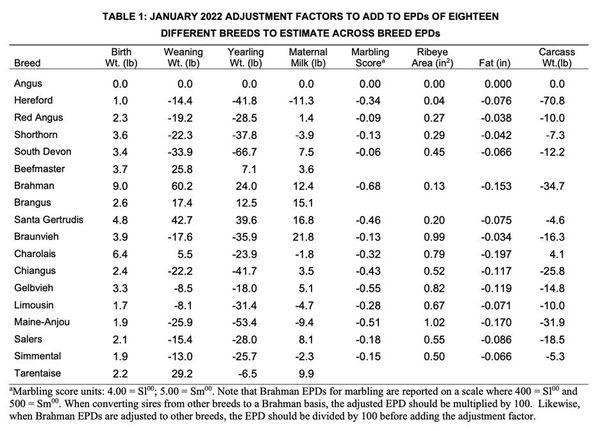
In this post, lets discuss how to improve the genetics of your herd and make more informed breeding decisions! Expected Progeny Differences (EPDs) are a powerful tool in modern cattle breeding that allows producers to predict the genetic potential of a bull’s offspring for specific traits, such as growth rate, milk production, carcass quality, and more.
Here's a simple guide on how to use EPDs effectively:

The Significant Role of the Beef Cattle Industry in American Agriculture
Post Date: August 8, 2023

In this post, let's take a moment to recognize the significant role of the beef industry in American agriculture. In 2021, the United States had a cattle population of 93.8 million, which included 9.4 million dairy cows. This robust industry produced a staggering 12.3 million tons of beef, contributing to approximately 17% of the global beef supply. The export of beef products generated a substantial revenue of around $9.9 billion in the same year.
Several states stand out as major contributors to the beef industry. Texas leads the pack with 4.3 million head of cattle, followed by Oklahoma with 1.98 million and Missouri with 1.95 million. Even states with smaller cattle populations, such as Mississippi with around 45,000 head of cattle, play a vital role, particularly in cow-calf operations that contribute to advancement within the reproduction sector of the industry.

The Ovum Pick-Up OPU Technique
Post Date: August 1, 2023
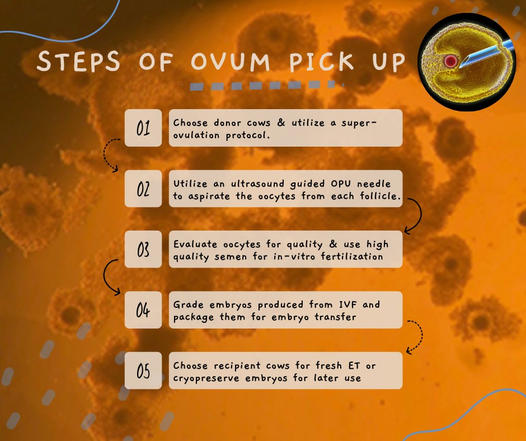
This post we will be discussing the ovum pick-up (OPU) technique. At the International Embryo Technology School, there is a whole course dedicated to teaching this technique. Specifically, veterinarians who are looking to expand their practice could benefit from this course!
Ovum Pick Up, or OPU, is a state-of-the-art reproductive technology that involves the retrieval of oocytes directly from the ovaries of donor cows. This non-invasive and carefully orchestrated procedure has opened up new horizons in cattle breeding, making it possible to multiply superior genetics at an unprecedented pace!

Keeping Cool in the Pasture
Post Date: July 28, 2023
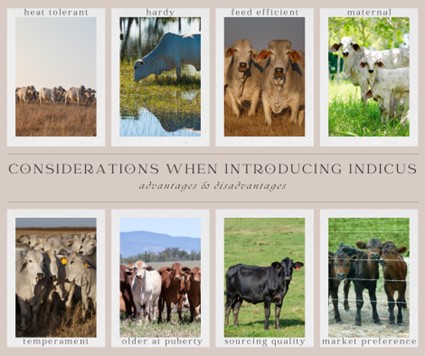
Harnessing Indicus Cattle Genetics for Heat Tolerance in Your Herd
The undeniable trend of increasing heat indices in the United States has had profound implications for cattle producers, particularly in regions unaccustomed to extreme heat. Traditionally cooler climates, like those in the Midwest and Northern states, are now grappling with the challenge of heat stress in their cattle herds. To counteract the serious side effects of heat stress, producers have had to implement a range of heat mitigation strategies. These include the provision of more shade, installation of fans in barns, water sprinkler systems, relocating cattle to pastures with readily available bodies of water, and increasing the number of water sources in pastures. However, these measures often come at a significant cost and, in some cases, offer limited relief during sweltering conditions. Consequently, many cattle experts are increasingly advocating for the incorporation of Indicus genetics into cattle operations across the United States in the coming years. The unique heat tolerance and adaptability traits of Indicus cattle could prove invaluable in safeguarding the health, productivity, and reproductive efficiency of herds in the face of escalating temperatures.

Heat Stress In Cow-Calf Pairs
Post Date: July 11, 2023
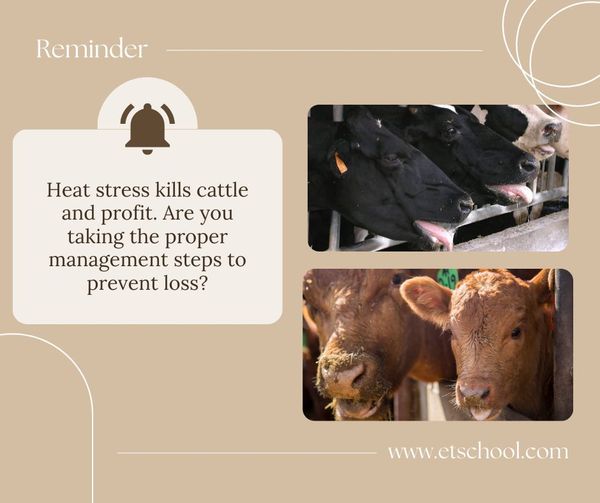
As we dive into the sweltering summer months, this post we will focus on heat stress in cow-calf pairs.
It's essential to be aware of the challenges cattle face during hot weather and how that can negatively impact their production potential. In order to ensure your pairs are performing to the best of their ability, here are a few key points to consider in management of heat stress:

Embryo Transfer In Dairy Cows
Post Date: June 13, 2023
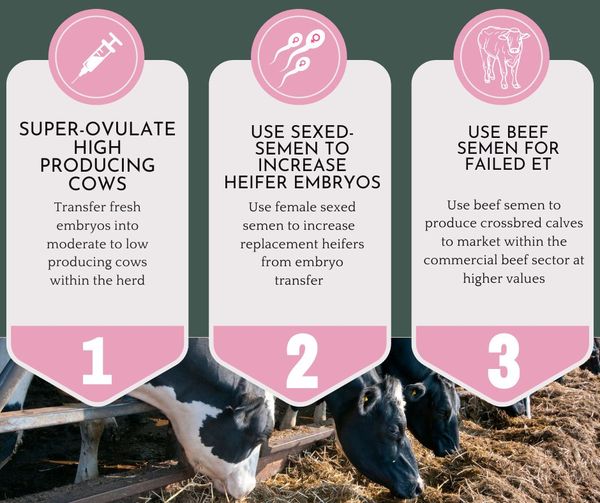
Embryo transfer can be a powerful tool in dairy operations. The basic superovulation protocol of donors with fresh embryo transfer into recipient females is easier in a confinement management situation. Moreover, combining the use of sexed-semen, embryo transfer, and beef on dairy could optimize overall production value.

Superovulation Protocol for Conventional Flushing of Donor Cows
Post Date: June 6, 2023
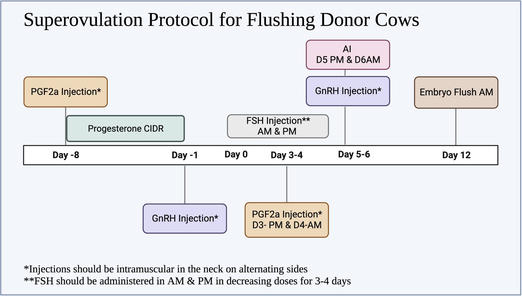
The most crucial component of Embryo Transfer is the generation of embryos! This can be done either through in-vitro fertilization or flushing embryos from a donor cow. Regardless, a superovulation protocol is highly recommended to increase the number of oocytes produced by the female translating to increased embryo yield per collection.
Today, we will discuss SUPEROVULATION PROTOCOLS FOR CONVENTIONAL FLUSHING OF DONOR COWS. Within this protocol, donor cows are given hormones to cause multiple follicles to ovulate resulting in more embryos produced.

7-Day Estrus Synchronization Protocol
Post Date: May 23, 2023

Embryo Transfer is a powerful reproductive technique that allows beef producers to multiply the genetic potential of their top-performing females. It involves collecting embryos from genetically superior donor cows and transferring them to recipient cows, which then carry and give birth to these valuable offspring.
Estrus synchronization protocols play a pivotal role in the success of embryo transfer programs. These protocols aim to synchronize the estrous cycles of both donor and recipient cows, ensuring optimal timing for embryo collection, transfer, and subsequent pregnancy establishment. By synchronizing multiple cows, producers can maximize the efficiency and success of the ET program.

Beef Cow Protocols
Post Date: May 16, 2023

When implementing an embryo transfer program, it is crucial to identify which females should be donors versus recipients. Depending on your operation, one may have zero donors or all donors likewise with recipients. Regardless, donor cows and recipients should meet minimum criteria before being assigned a role within an embryo transfer program. All cows should pass a general clinical exam to identify:

Embryo Transfer: Donors and Recipients
Post Date: April 5, 2023
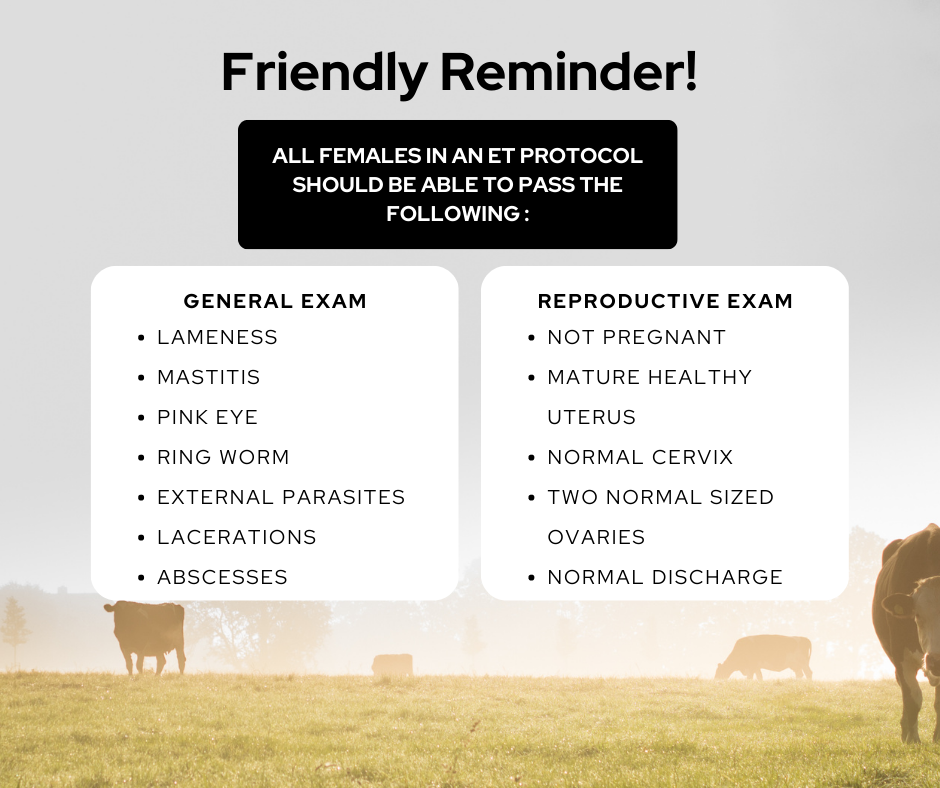
When implementing an embryo transfer program, it is crucial to identify which females should be donors versus recipients. Depending on your operation, one may have zero donors or all donors likewise with recipients. Regardless, donor cows and recipients should meet minimum criteria before being assigned a role within an embryo transfer program. All cows should pass a general clinical exam to identify:

Requirements For Females Used In Bovine Embryo Transfer Protocols
Post Date: March 28, 2023
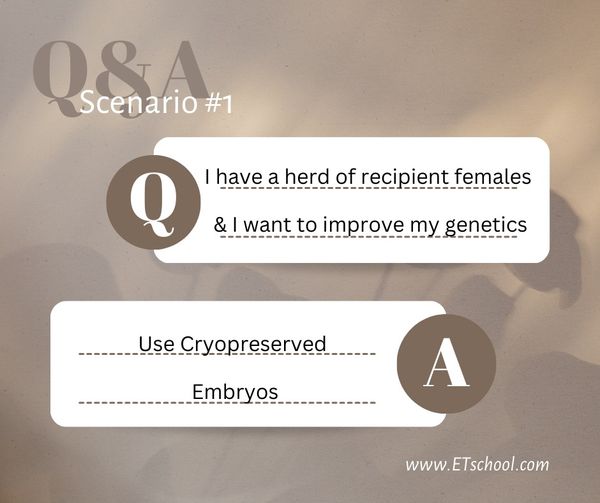
For this post, we would like to discuss general requirements for any females being used in embryo transfer protocols. All females should undergo a general clinical exam to identify any:

Selecting Embryo Recipient Cows
Post Date: March 21, 2023
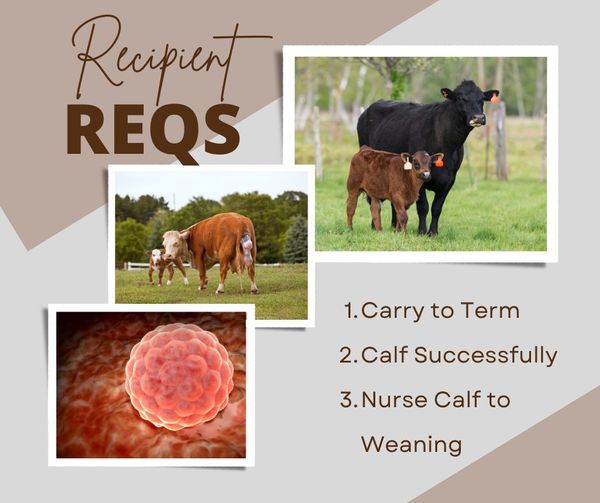
Recipient cows have more requirements than donors for good reason, these are the females responsible for carrying the embryo to term, calving successfully, and nursing the calf until weaning. Recipients should be carefully screened to ensure they are capable of these tasks prior to embryo transfer. This post we will give you a list to double check for all your recipients this breeding season.

Selecting Embryo Donor Cows
Post Date: March 7, 2023
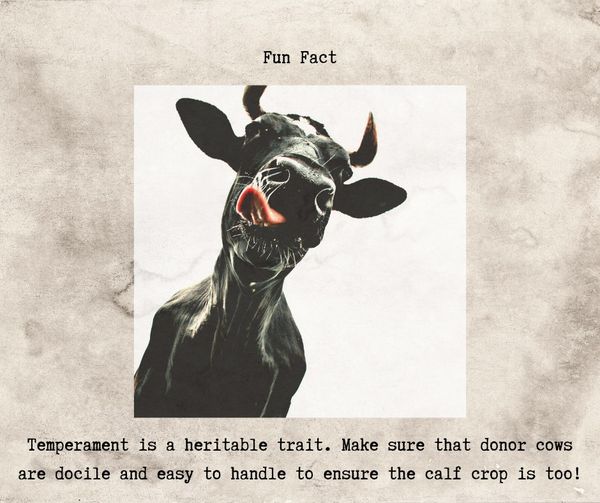
What makes a female ‘high-quality’ enough to be an embryo donor? This post we will discuss what characteristics we look for in our donor females.

How To Grade Bovine Embryos
Post Date: February 13, 2023
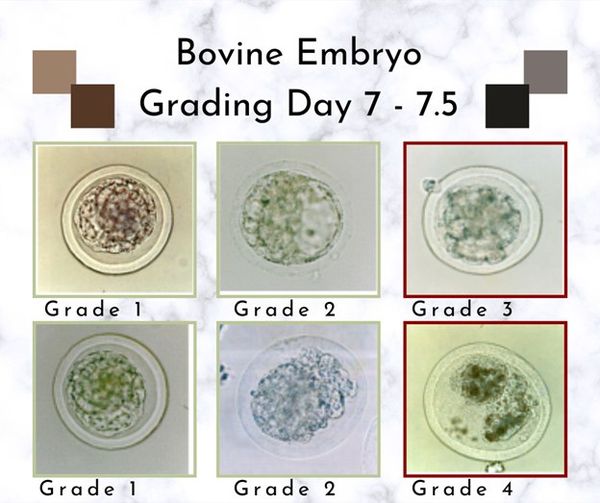
For this post, we would like to discuss the difference between In-Vitro Embryos Versus In-Vivo Produced Embryos.

In-Vitro Embryos Versus In-Vivo Produced Embryos
Post Date: February 7, 2023
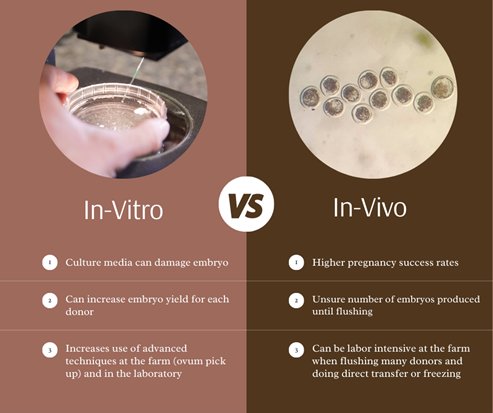
For this post, we would like to discuss the difference between In-Vitro Embryos Versus In-Vivo Produced Embryos.

Differences in Fresh Versus Cryopreserved Embryos
Post Date: January 31, 2023

For this post, we would like to discuss the different types of embryos that can be used for embryo transfer. Each embryo type has different pregnancy success rates, associated labor, and equipment requirements. This post we are going to discuss the differences in fresh versus cryopreserved embryos.

Reproductive Issues That Can Be Alleviated by Using Embryo Transfer
Post Date: January 24, 2023
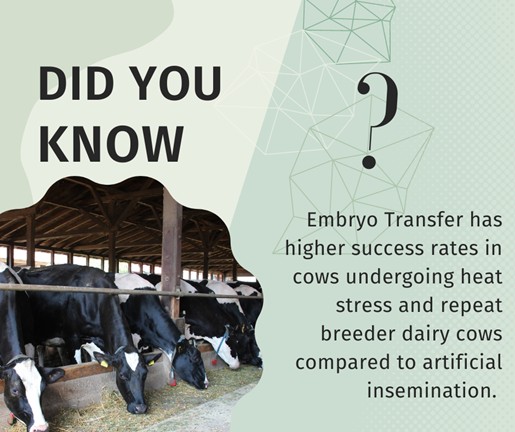
While embryo transfer is advantageous to any cattle operation, research had identified two reproductive issues that can be alleviated by using embryo transfer. It is shown that dairy cows undergoing heat stress or repeat breeder dairy cows have higher pregnancy rates to embryo transfer than traditional artificial insemination.

Considerations For Implementing Embryo Transfer
Post Date: January 17, 2023

Evolution of Embryo Transfer
Nearly 132 years ago, in 1891, embryo transfer (ET) was achieved using rabbits. However, it took an additional 80 years for embryo transfer to be adopted as a routine practice within the cattle industry. Over the last half century, embryo transfer has revolutionized cattle reproduction. This technology allows genetically superior females to have multiple calves per year through a surrogacy process in recipient females. Where producers used to be limited to one high dollar calf per year from their best female, now they can collect oocytes from their best female, fertilize them using in-vitro fertilization, and transfer all viable embryos into recipients. Thus, embryo transfer is a technique to quickly multiply the genetics of top females in a herd.

Tips for Sucessful Bovine Artificial Insemination
Post Date: January 3, 2023
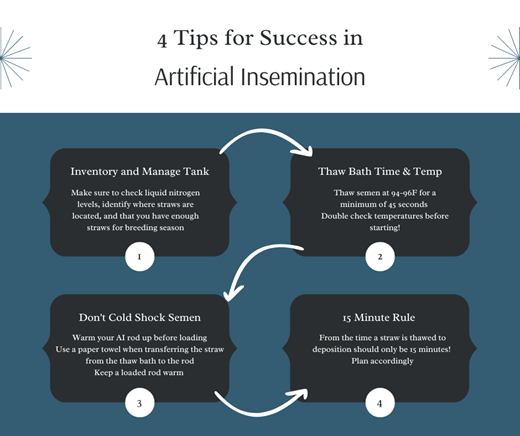
For this post, we want to remind you of the old time saying that “practice makes perfect”. This rings true especially when learning new reproductive techniques such as artificial insemination or embryo transfer.
However, learning how to AI without prior guidance can be extremely difficult. We offer a course that includes AI and embryo transfer techniques. This course provides you with a solid foundation of knowledge to take back to your operation and practice implementing these advanced reproductive techniques.
Once you have your foundation, there are some key components to remember:

Dairy Cattle Body Condition Scoring BCS
Post Date: December 13, 2022
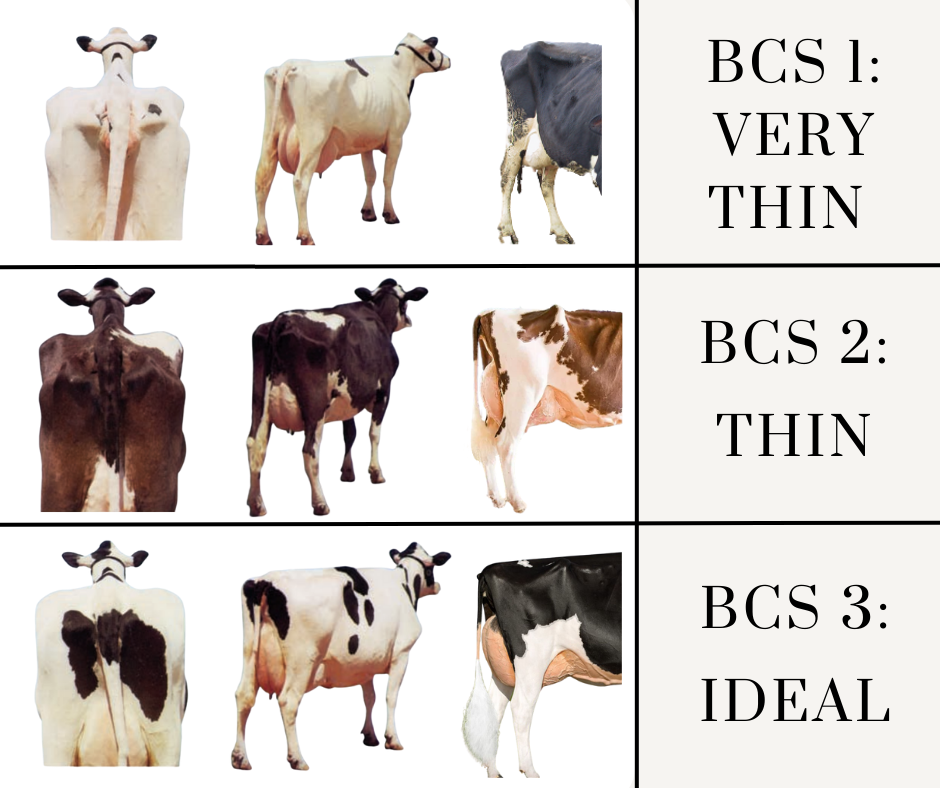
This post we are focusing on dairy cow body condition scoring to increase both lactation and reproductive performance
The dairy body condition scoring system is on a scale from 1-5 with the ideal cow being a score of 3. Dairy cows are typically scored using a +/- 0.25 scale. Thus, it is common for cows to be scored a 1.75, 2.5, 3.25 etc. Dairy cows have the highest energy demands amongst livestock species, meaning they are constantly in a negative energy balance. This is reflected by decreased fat deposition on the body because excess nutrients go towards lactation instead of being stored as fat. This is reflected by a thinner body frame compared to beef cattle.

Artificial Insemination: Semen Storage & Handling
Post Date: December 6, 2022

Introducing artificial insemination (AI) into your operation can seem like a daunting task but understanding basic principles will allow you to easily begin incorporating the technique and reaping the economic benefits. Cows bred via AI produce genetically superior calves based on producer preference and selection. Moreover, cows bred to AI calve earlier leading to an increased calving interval in dams and increased weaning weights.
This article focuses on principles of semen storage and handling in artificial insemination and provides research-based management practices to increase success.

Bovine Winter Nutrition Considerations
Post Date: November 29, 2022
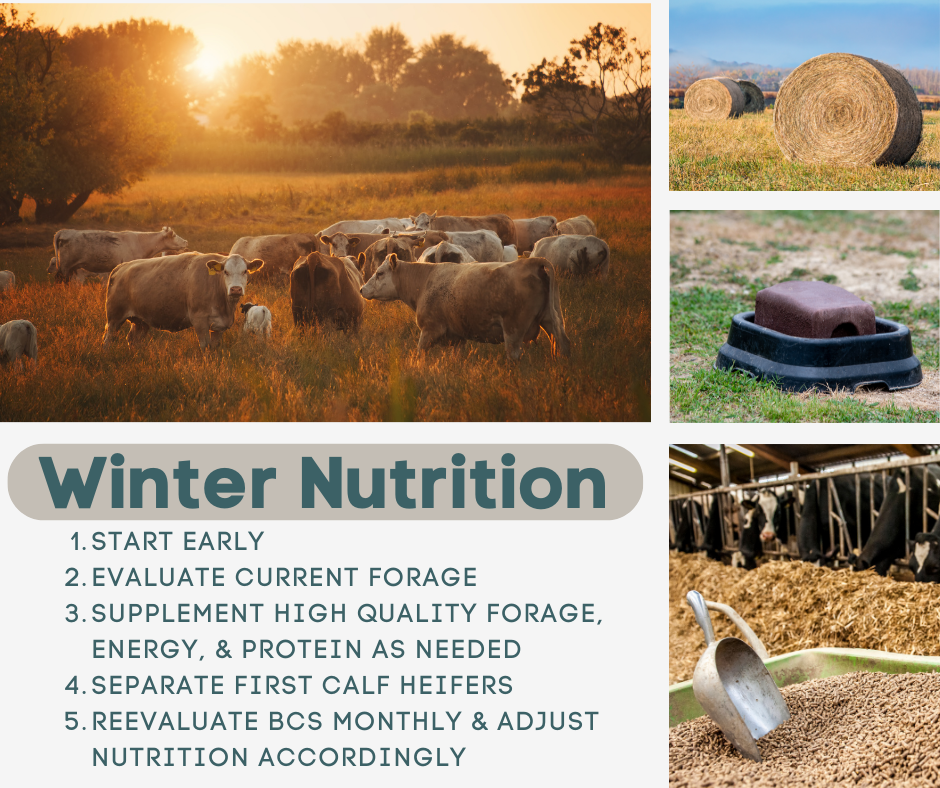
This post we want to discuss how to adjust nutrition this winter to meet your cow’s needs to be successful in the spring breeding season. Last week we discussed body condition scoring (BCS), if the majority of your herd is below a BCS 5 you need to up their nutrition over the winter months. Here is how:

Beef Cattle Body Condition Scoring BCS
Post Date: November 22, 2022

It seems like has become winter over the weekend in Mississippi and across most of the United States! So, for this post we are focusing on preparing your herd for nutritional and reproductive success over the winter.
Over the winter months, forage quality and quantity decrease. Lack of nutrient availability paired with weather stress will lead to cows losing weight. This is particularly concerning in spring-calving cows as a reduction in body condition will result in impaired calf health and cow reproductive success.

Who Would Benefit From Attending Our Bovine Reproduction Courses?
Post Date: November 8, 2022

In this post We want to discuss WHO would benefit from attending one of our bovine courses to learn skills such as artificial insemination (AI), embryo transfer (ET), ovum pick-up (OPU), in-vitro fertilization (IVF), and reproductive management strategies.

Utilizing Cryopreserved Embryos
Post Date: November 1, 2022

In this post we will be discussing another important advancement in reproductive technologies, cryopreserved embryos, and the ability to ship those embryos to cattle operations around the world.
The most obvious advantage of using cryopreserved embryos is the ability to use genetically average dams to produce elite calves. Purchasable cryopreserved embryos have superior genetics on both the dam and sire side (versus just the sire when using cryopreserved semen). Thus, the current genetics available on your operation does not have to contribute to the genetic merit of the offspring produced.

Assistive Reproductive Technologies (ART) And Their Current Implementation Within the Cattle Industry
Post Date: October 11, 2022
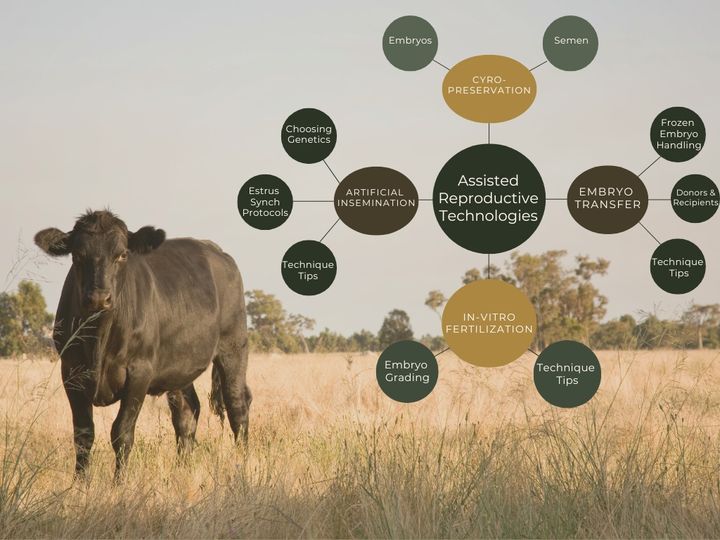
This Post discusses assistive reproductive technologies (ART) and their current implementation within the cattle industry. The most prevalent ART within cattle reproduction includes cryopreservation, artificial insemination (AI), embryo transfer (ET), and in-vitro fertilization (IVF) techniques. The implementation of just one ART on an operation can greatly advance:

Latest Research Regarding Function of a Corpus Luteum (CL) in Recipients
Post Date: April 24, 2018
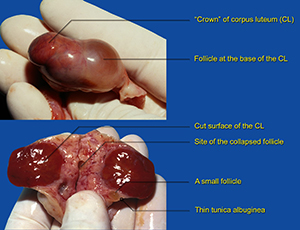
With rising costs and decreasing value of cows it is more than time to tighten the belt. There is significant expense and time in preparing recipients to receive an embryo. They may have been purchased for this purpose, shipped home, vaccinated, wormed, estrous synchronized, observed for standing heat all of which results in around $100 above market price for that animal.
Recipients are selected on the basis of condition, regular estrous cycles, successful estimated time of heat, presence of a CL, a term most of you will be familiar with and must be present on the day of embryo transfer. The function of a CL is to make progesterone which helps to prepare the egg in the follicle and prepares the uterus for the anticipated pregnancy...

Selecting & Preparing Embryo Transfer Recipients
Post Date: February 5, 2018
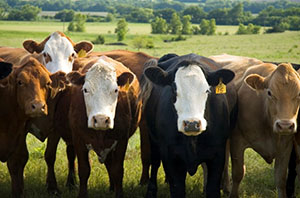
A common failure in embryo transfer programs is the selection and preparation of recipients. I am often asked which breed should be selected for receiving embryos. To date there is no evidence that any Bos Taurus (British and European) breed is superior. However, many years ago we found Bos Indicus (African and Asian) cattle proved to be poor recipients but their crosses perform at a similar rate. Unfortunately, one-time, or first-time users of embryo transfer too often try using animals which have previously failed in their own breeding program with disappointing results. Sustaining programs select good quality animals resulting in consistent satisfactory pregnancy rates, e.g., 67% pregnancy rates transferring fresh embryos, and 50% for frozen thawed embryos initially graded as 1s and 2s. In one of our early frozen embryo programs we achieved 12% WEANED CALVES born when number 3 grade embryos were transferred...

Development of Bovine Reproductive Practices over the Last 120 Years
Post Date: September 6, 2017

I've always been interested in history so I thought it would be interesting to briefly look back at the developments in my field of bovine reproduction and as the saying goes learn from history, so our activities over the past may point out our failures and successes.
In 1896 Walter Heap in Cambridge England published methods of recovering and transferring embryos which were some of the first embryos observed. In 1900 Ivanoff in Russia developed an artificial (AI) insemination technique for cattle. Since this activity requires selection of superior genetics to be of use in improving cattle it was serendipitous that shortly after the first genetic evaluations were calculated based on multi-herd performance. The first AI in the USA was in 1925, and in the early 1940s Trimberger introduced the AM PM principals for breeding cows. Semen straws were developed in the early 1940s. In the 1950s Chris Polge in Cambridge decided to try glycerol as a cryoprotectant when freezing spermatozoa, at that time he was working with swine semen...

Common Problems with AI and ET
Post Date: June 6, 2017
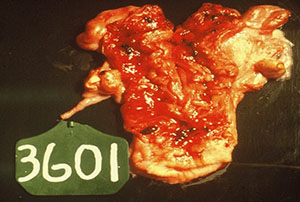
Frequently I have heard of artificial insemination (AI) technicians claiming higher pregnancy rates when semen is placed in the uterine horns. However, a study (Can. VET. J. 1965) reported that AI technicians frequently deposited semen in the wrong horn. For example, when the left horn was selected only 14% were correct; and only 48% were successful on the right horn (they must have been predominantly left hand palpaters).
A more recent study (Therio.67,754-759) confirmed the earlier work when semen was deposited in the body of the uterus, the horns, or by surgical techniques at the junction of the uterus and oviduct, there were no significant differences in pregnancy rates...

Using CIDRs to Improve Pregnancy Rates
Post Date: February 6, 2017
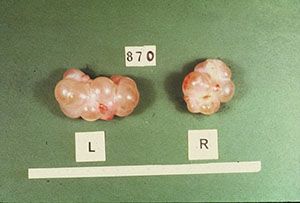
There have been many attempts to improve pregnancy rates by administering progesterone (PG) from injections to vaginal suppositories. Unfortunately, results have been well below expectations but have improved with the advent of controlled intravaginal releasing devices (CIDRs) for synchronizing estrus improving CLs (corpus luteum) resulting in larger follicles producing higher quality eggs.
CIDRs contain 1.9g of P4. They release 610mg of P4 averaging 87mg/day into the blood stream of the cow. High producing dairy cows metabolize high rates of P4 due to the large blood liver flow. Therefor one CIDR increases P4 by only 0.78ng/ml in a lactating cow after 7 days of application, compared to 4 to 5.8ng/ml in an untreated cow. From these findings one CIDR is insufficient to improve P4 levels needed to sustain a CL resulting in larger follicles and improved quality of eggs...

Factors Affecting Pregnancy Rates in Embryo Transfer Programs
Post Date: December 6, 2016
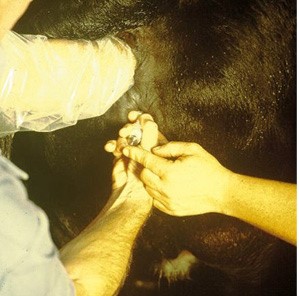
A recently published paper reported their results in (Theriogenology, 86 2016 1834-1841) from 516 embryo collections and 10,297 embryo transfers. This work was performed on Holstein cows but the results could be applied to beef cattle. Some of the factors you probably know but some you will not be aware of. In addition the performance of IVF embryos are included and compared to regularly collected embryos. In general cows which had previously produced calves yielded more eggs (as compared to embryos) and a lower percentage of transferable quality embryos (TQE) compared to females that have not produced a calf (see table one)...

Our Achilles Heel
Post Date: September 6, 2016
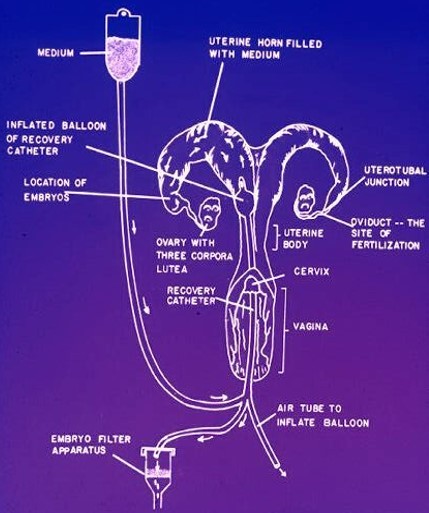
The Achilles heel of the embryo transfer industry is the unpredictability of the final results even when optimum techniques have been utilized by experienced persons. I have often thought we should regularly obtain at least a 90% pregnancy rate when considering number one quality embryos were correctly transferred, by an experienced technician into a prepared recipient with a recognized corpus luteum (CL) and no detectable infections. I would even say 100% but one has to allow 10% for human error!
A recent publication (Sirard et al) reported the occurrence of transcriptional modifications (changes in the DNA) of eggs leading to lower quality eggs and subsequent lower quality embryos with resulting disappointing pregnancy rates. It is surmised that these modifications occur due to large doses of Follicle Stimulating Hormone (FSH) injected into selected donors the process known as superovulation. The injected FSH is much larger than the surges of FSH released by the animal herself. So use conservative doses of the hormone. Take careful records of FSH doses and record subsequent responses e.g. size of ovaries at flush time, number of eggs, transferable quality and degenerate embryos....

Straws Exploding While Thawing
Post Date: May 24, 2016

We have all experienced frozen straws containing embryos or semen exploding when exposed to the environment or water in the thermos. Unfortunately, the person thawing is accused of making a mistake, but the fault is due to the technician who froze the embryos not sealing the straw prior to cooling and deep freeze. When even a spicule of a hole is present liquid nitrogen enters the straw due to contraction of the air in the straw therefore It is essential that both ends of the straw are sealed. In one end of the straw cotton plugs hold PVC powder in place, and the powder forms the seal when moistened with media. On occasions the cotton at the end of the straw is not moistened by media in the straw when an air space is between the media and the cotton. The freezing process causes contraction of the air space in the straw which draws the liquid nitrogen into the straw. But on thawing and meeting a warm environment the liquid nitrogen rapidly expands causing an explosion.
Other causes of careless sealing are, heat sealing at the wrong temperature. If the heat sealer is too hot the plastic in the straw melts or if the heat sealer is too cool the plastic is not fused together, in both cases nitrogen enters the straw during cooling. I recently received a report of failing plugs causing leakage, either they were poor quality or placed incorrectly in the end of the straw. Sealing waxes were briefly popular but proved unreliable, in fact the wax would ooze out of the straw in a hot room before freezing...

Factors Affecting Bovine Pregnancy
Post Date: April 5, 2016

I have often speculated after carefully transferring a #1 embryo into a recipient with a known corpus luteum (CL), on the correct date of the estrous cycle, following regular cycles, why do we not achieve pregnancy rates around 90 to 100 per cent? As we all know that rarely occurs at least when significant numbers of embryos are transferred. But of course when one stops to think about the number of variants in the process then sanity returns. So what are these other factors affecting our results?
First is the quality of the recipient herself. Too often when this industry started or when one scores a new client, recipients are selected from cows that failed in the regular breeding program, or are in poor condition (too fat, too thin). Possibly the belief is that we are not using these genetics since the embryo is supplying a new set of desirable genes. But unsatisfactory recipients often result in increased dystocia (difficult calving), produce poor quality colostrum, low milk production and poor mothering ability. ...

What to Look for When Purchasing Frozen Embryos
Post Date: February 6, 2016
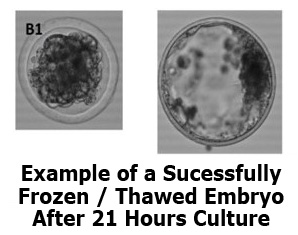
The survival of frozen-thawed-transferred embryos depends on several factors, and they are based on a subjective classification of quality expressed as #1, 2 or 3 meaning excellent, good or fair quality. However, classification is not 100% reliable as the grading scores vary among practitioners, plus as we have learned over the relatively brief years of embryo transfer, embryos recorded as #1 from one donor may result in excellent pregnancy rates, while #1 embryos from another donor may result in a very disappointing pregnancy rate.
Many practitioners and researchers describe good quality embryos as viable which is not an accurate term and possibly leads to the thought that a calf will result more often from an embryo described as viable after transfer. The correct terminology is a transferable quality embryo. Viable means, capable of developing and growing and this is not always the case. But there are other factors (apart from the quality and preparation of the recipient) which can be a significant help in predicting pregnancy rates...

Cumulus Cells on Retrieved Eggs & Embryos from Superovulated Cows
Post Date: January 6, 2016
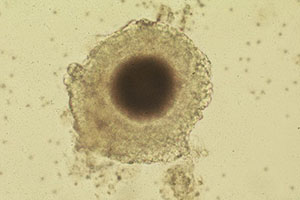
Recently an experienced embryo transfer practitioner collected some eggs and embryos from a superovulated donor cow. On examination of the eggs and embryos he observed they were still covered in cumulus cells which is very unusual since they came from the uterus. Cumulus cells feed the oocytes (eggs) while they are in the ovaries and follicles but disappear by the time they enter the uterus via the oviducts. Stay with me, there is a useful sequence to this unusual occurrence, which one day may be of benefit to owners using embryo transfer to improve their livestock.
I first observed cumulus cells on embryos many years ago. We flushed a Holstein heifer exhibiting an excellent response to the superovulation treatment, but only 3 number 1 embryos were recovered when we were expecting around 10. Immediately after the flush I had to rush over to the vet school to give a lecture to the students on reproductive diseases. During this time the unexpected poor result of the flush was on my mind so I decided to repeat the flush...

Body Condition & Pregnancy Rates
Post Date: November 10, 2015
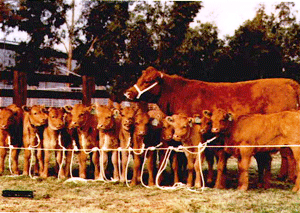
When I was running the CSU embryo transfer laboratory our mission was in applying our research results to see if they worked in the commercial field. There are many examples where a technique works in the laboratory but does not function efficiently when applied commercially. We had over 1,000 recipients which were observed for estrus twice per day. A pregnancy rate of 67% was consistently maintained with fresh embryos graded from 1 to 3.
It was always a problem and expense in locating and preparing suitable potential recipients, so when Holstein heifers became available in a feed lot program we accepted providing they were used as recipients once only, since they were on a feedlot fattening ration. The pregnant recipients were sold to the owners of the donors and the failed recipients continued in the feedlot program...

Embryo Placement in the Uterus
Post Date: October 27, 2015
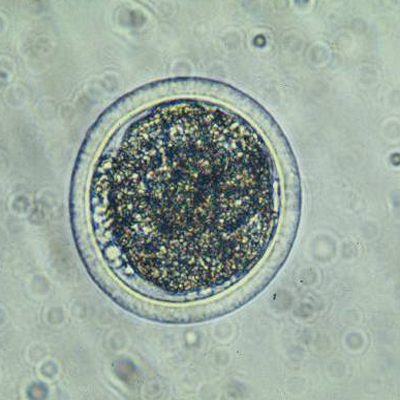
Recently there has been some discussion regarding establishment of a pregnancy when the embryo is placed in the incorrect uterine horn, referred to as the contralateral horn,
which is the side not containing the corpus luteum (CL) on the ovary.
Some reports claim pregnancies are established in these cases, although they usually are lost. While other experienced embryo transfer technicians have not observed this phenomena. Bear in mind 20% of Holsteins and Simmentals exibit two CLs per cycle in which side of delivery is of no consequence.
Several years ago in order to settle the argument we conducted a small experiment, placing 20 embryos in the horn opposite to the CL and another 20 embryos in the horn next to the CL. Pregnancy rates were 0 and 65 %, respectively. In conclusion, based on the facts, place the embryo in the horn next to the CL...

Importance Of Placement Of Embryos In The Uterine Horn
Post Date: October 1, 2015
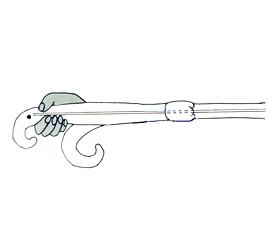
Steel reported that embryos graded # 1 (859) resulted in equal pregnancy rates when they were placed in either lower, middle or upper one third of the horn (73%, 73%, and 74%) respectively next to the CL on the ovary, providing the embryo was deposited past the palpable division of the horns.
However, there were significant differences in pregnancy rates for embryos graded 2 or 3 when they were placed in different parts of the horn. As expected when the embryo was delivered in the upper one third of the horn a pregnancy rate of 66% (209 embryos) was achieved, but for # 2 embryos 59% (151 embryos) pregnancy rate when placed in the middle one third of the horn and only 49% (41 embryos) when placed in the lower one third of the horn...

Heat Stress A Problem In Bovine Reproduction
Post Date: September 1, 2015
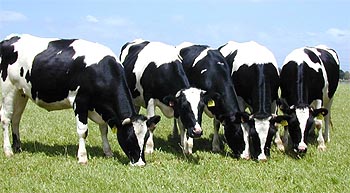
We received several calls this summer regarding below average embryo collections and unsatisfactory pregnancy results in recipients. These concerns led to the creation of this article which addresses heat stress and its effects on bovine reproduction.
Global warming is a term we are all familiar with and as the name denotes temperatures are higher than usual, especially this summer, where record high temperatures have been experienced. But these temperatures were preceded with record cold temperatures. A more accurate term would be climate change.
So how do these changes affect the cattle breeder? There are several consequences due to inclement weather patterns resulting in multiple heat stresses...

Bovine Embryo Classification And Grading
Post Date: August 1, 2015
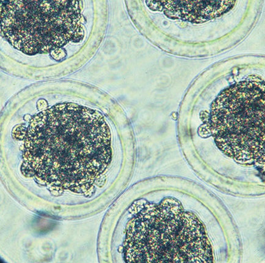
Recently a cattle owner contacted me regarding frozen embryo classification. He had some frozen embryos stored, classified as Stage 4 which are embryos developed to the compact morula stage usually observed 6 days after first observed standing heat (estrus). He had been informed by several contacts that he should discard these Stage 4 embryos, which would have been a significant number as they had been stored over the years, but fortunately he did not discard them. This alarming misinformation had come from several informants and subsequently stimulated the following article:
The International Embryo Transfer Society in the early 1980s promoted and encouraged embryo transfer practitioners to grade embryos with guidelines into 4 groups. The number 1's would be called excellent, the number 2's called good, the number 3's would be fair and the number 4's are dead or degenerated...

Affect of PH on Bovine Pregnancy
Post Date: October 12, 2015
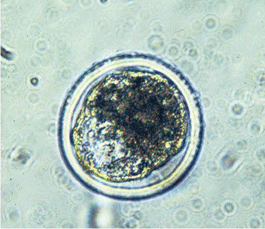
There was an interesting question on the affect of pH in the uterus and its effect on an embryo and subsequent pregnancy. The pH of the healthy vagina is around 4, cervical mucus 8.4, uterus 7.6 and oviductal fluid in the follicular phase 7.3 and in the luteal phase 7.5 to 7.8. There is ample evidence that pH changes with diet. It is seen in high producing dairy cattle consuming large amounts of excess protein contributing to reduced progesterone levels with an allied increase in prostaglandin production and a decrease in uterine pH resulting in decreased embryo development.
Similarly in beef cattle on high protein lush, spring grass, or suddenly changed from a relatively dry feed to young rye grass. Media used in embryo transfer range from a pH of 7.2 to 7.6 to mimic the conditions in the uterus, this pH is especially important for spermatozoa (semen) which are far more sensitive to even small changes of pH outside the normal range...

Superovulation Protocol Modification
Post Date: June 5, 2015
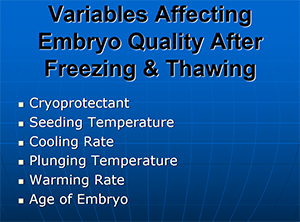
The problem of low pregnancy rates following the transfer of previously frozen embryos has significantly decreased over the years, but it still does occur as demonstrated in a recent court case. Usually the transfer technician is accused of unacceptable quality work as he/she is the last person to handle the embryo. However, fault may be due to many other persons in the steps to produce the final product e.g. selection of poor quality embryos to freeze, unacceptable freezing techniques, poor embryo storage practices, recipients too fat or too thin, inaccurate heat detection, inadequate records etc...
As the technician performing the work, or as the donor owner selling the embryos, there is an excellent method to protect oneself: Following embryo and egg collection there are in most cases eggs and degenerate embryos observed. Prepare these normally discarded eggs and embryos for freezing the same as for valuable embryos and place them all in one straw. Around -30°C place the test straw in the liquid nitrogen tank for approximately one minute. Remove this straw from the tank, thaw and examine the eggs and embryos and record the results. If there is a problem with the freezing method there will be many zona cracks. About 10 to 15 percent of zonae will have one crack even with excellent freezing techniques. Eggs are quite acceptable for this technique...

Improving Bovine Pregnancy Rates
Post Date: May 6, 2015
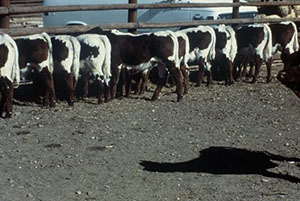
Unacceptable low pregnancy rates can be due to poor management practices of donors and recipients and not the often expected poor embryo technology. The most common practices causing stress can be divided into, incorrect condition of donors and recipients, transportation problems, rough handling of cattle, inadequate management of liquid nitrogen tanks and their contents, and unfortunately unknown causes.
When synchronizing recipients using the two shot prostaglandin (PG) system and only 30-40% show standing heat, that is the time to cancel the program. Usually after the second shot only 50-60% respond. In addition when those relative few recipients are implanted pregnancy rates are unacceptably low. These results are due to the demise of the corpus luteum (CL) by Day 21. Results such as these can be backed-up by a published study of Kunkel et al in Theriogenology in which pregnancy rates after artificial insemination are related to the physical condition of the cattle. For instance cows rated as a body score of thin #3 achieved a low 43% pregnancy rate, a #4 only achieved a 61% pregnancy rate, and a #6 achieved a very good 93% pregnancy rate, but as a fat #8 pregnancy rate was down to 50%. How many times are we presented with poor quality recipients, sometimes the rejects from the usual breeding program?...

Increasing Reliability of Donor Response
Post Date: March 6, 2015
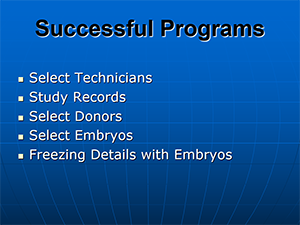
When considering where to apply management practices the three main areas should be apportioned as follows, 47% on reproduction, 24% on growth and 29% on carcass traits. As can be seen reproduction is by far the most important especially today with the high price of cattle so that even one more calf is significant. This relates to two more embryos achieved by improved management of donors plus some additional selection criteria which will be explained.
One new management tool is measuring anti-mullerian hormone (AMH) in donors. This hormone is related to oocyte (egg) reserves in cells found in the follicles. AMH is made in the granulosa cells in the follicles , so the larger number of follicles (all containing one oocyte) the higher is the concentration of AMH as measured in the blood of the donor. Samples can be taken at any time of the estrous cycle and should be refrigerated while waiting shipment to a laboratory. It is a good idea to speak to laboratory personnel initially to see how they want the sample handled and shipped, including the day of the week to avoid weekends and holidays...

Possibilities for Increasing Pregnancy Rates in Embryo Recipients
Post Date: September 6, 2014

The average age of a cattle livestock owner is 58, so where are the future beef producers? The world population is supposed to double by 2050 so food production must significantly increase. One attraction for young people has to be applied technology. In our case starting with artificial insemination, estrous synchronization, and embryo transfer. Previous producers have only seen about 4 generations of cattle so improvements are relatively slow, particularly in the minds of the young producers. So we believe our embryo transfer school is delivering a valuable service to the cattle industry by introducing students (from 16 to 80 years old) to this technology and opening up an interesting, challenging , lifelong changing new world. New innovations of recognized technologies are frequently being tried, most fail but some are successful, one of these recent discoveries is the improvement of recipient pregnancies.
There have been many attempts to improve transferred embryo pregnancy rate for instance administering progesterone by injection, via vaginal mucosa absorption after deposition of the embryo or by a prostaglandin antagonist such as phenylbutazone, also additives to the media containing the embryos have been tried but none have stood the test of time. In fact there have been so many claims of success if they were all applied at the same time then the pregnancy rate would be 150%...

Practical Strategies Which Can Be Used to Enhance Embryo Survival Rates
Post Date: September 6, 2012
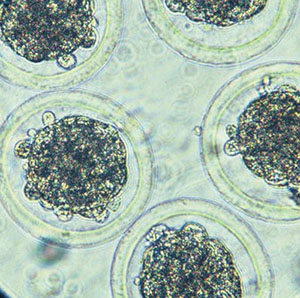
We are often asked how to increase embryo survival rates. Below are several practical strategies which can be used. If you have any questions please feel free to contact us.
- Make sure your cattle are getting proper nutrition. Palatable dry matter containing high energy is essential, without the latter CLs on the ovaries tend to disappear before the end of the first cycle terminating the early pregnancy. This occurs especially when grass is in the spring flush. Ensure clean water and watch for algae in times of drought.
- A comprehensive vaccination program is also essential, covering the clostridia family of diseases and the respiratory complex of diseases. Plus you may have some additional diseases to cover specific to your area. Discuss this subject with your veterinarian...
Flushing & Embryo Classification
Post Date: April 5, 2012
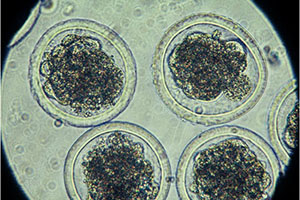
I am often asked why elevate the head end of the donor? Embryos and eggs are in the tip of the uterine horn next to the utero-tubal junction. In order to wash them out the medium has to completely fill the uterus all the way to the end. In heifers and young cows the uterus is in the pelvic cavity and easily within reach for manipulation during the filling and emptying process. But in mature donor cows the uterus is frequently partly or entirely in the abdominal cavity and must be pulled back into the pelvic cavity for efficient and safe flushing.
This can be accomplished by retracting the uterus by the inter-cornual ligament easily located at the base of the dividing horns, and then it must be held there during the flushing process in order to assess how full the uterus is with medium. Obviously if the donor is elevated at the front it is easier to maintain the pelvic position and the operator can estimate if the two horns are filling as required and avoid over filling and a ruptured wall of the uterus...

Testimonials
"My time was well spent at The International Embryo Technology School, it was one of the best things I have ever done to date. Thus taking the course has given me a great advantage in the purebred cattle industry and an awesome outlook in the business world."
Rodney Hollman
"Just wanted to let you know how valuable your course has been for me. The presentation of information and techniques was great! Being able to perform embryo transfer has added much value to my practice."
Jan Michler DVM
"I just wanted to say I think the tuition for your class was the best money I've ever spent for continuing education. I really appreciated the way things were presented. They left no grey areas about which methods and techniques were best."
Bruce l. Chambers DVM
"I now have calves on the ground from my ET work thanks to you. My conception rate on frozen embryos is in the 60s right now. Thank you for the schooling."
Doug Giles

|
|
|